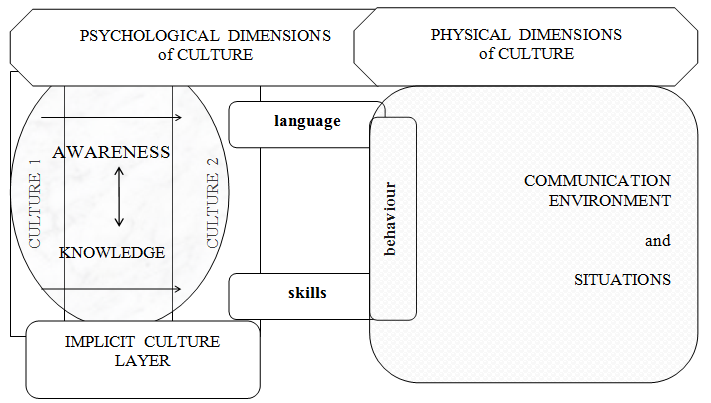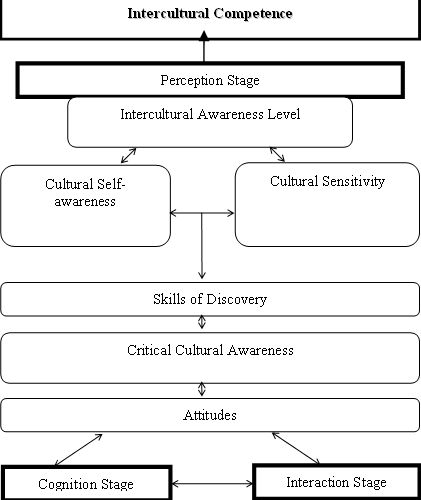INTERCULTURAL DIMENSIONS OF TEACHING AND LEARNING IN AN LSP COURSE
Пригожина К.Б.
Кандидат педагогических наук, Российский экономический университет им. Г.В. Плеханова
«МЕЖКУЛЬТУРНЫЕ АСПЕКТЫ В ПРЕПОДАВАНИИ ЯЗЫКА ДЛЯ СПЕЦИАЛЬНЫХ ЦЕЛЕЙ»
Аннотация
Публикация посвящена рассмотрению и анализу способов организации процесса обучения иностранному языку для специальных целей на основе изучения культуры и ее основных параметров. Цель статьи – выделение этапов формирования межкультурной компетенции и описание задач, решаемых на каждом этапе.
Prigozhina K.B.
PhD in education, Plekhanov Russian University of Economics/ Department of Foreign Languages, Moscow, Russia
INTERCULTURAL DIMENSIONS OF TEACHING AND LEARNING IN AN LSP COURSE
Abstract
The article aims to identify and clarify the ways of integrating culture and its dimensions into the context of an LSP course. Special attention in an LSP course is to be paid to raising students’ cultural awareness as well as structuring and comparing culture concept frames, which will further determine the choice and flexibility of behavioural strategies.
Key words: culture concept frame, intercultural dimensions, intercultural competence, LSP course.
In today’s world an increasing number of companies are facing intercultural challenges due to the economic globalization and the opening of new markets. Professionals in the global business environment deal with different values, behavioural norms, and ways of perceiving reality as they are involved in intercultural communication with partners. Consequently, intercultural competencies have become important for a larger number of people than ever before. As diversity of cultural values is penetrating into and influencing professional intercultural communication, intercultural dimensions are supposed to be introduced into teaching process in an LSP course. In order to prepare students for effective intercultural communication, it is necessary for teaching professionals to identify, clarify, and find the most effective ways to integrate culture and its dimensions into the context of LSP course.
Since the aims of any LSP course are rather straightforward, it has to focus on satisfying clearly defined specific needs of students, with clearly structured course program. Special attention of an LSP course is to be paid first of all to raising cultural awareness of students. Therefore, it is important to focus on structuring and comparing culture concept frames, which will further determine the choice and flexibility of behavioural strategies.
To interact effectively and efficiently in the intercultural environment it is essential to be aware of all the cultural factors that affect communication processes. Among these factors are three primary cultural dimensions – the languages, the physical factor, and the psychological factor [2]. These three dimensions of culture are interdependent (Fig. 1). Reference [3], who introduced cognitive approach to studying culture, states that different cultures structure knowledge differently. These differences determine aspects of behaviour and communication. The language dimension is used as a verbal/nonverbal code/mode to convey the idea (or meaning) that is influenced by cultural peculiarities, shaped and transformed psychologically. The psychological dimension relates to our knowledge, beliefs, and mental activities, and can therefore be categorized to implicit cultural layer. The language and the psychological dimensions are reflected in a person’s behaviour within a certain environment – the physical dimension.

Figure 1. Intercultural Dimensions in Communication Processes
Intercultural dimensions, if considered in combination, contribute to the development of intercultural competence in students within language learning processes. Culture cannot be taught, it can be perceived. For this reason, it is essential for any LSP course first of all to raise cultural awareness, enrich cultural knowledge, and make attitudes to cultures and assumptions about culture peculiarities more flexible. It appears therefore that structurally intercultural competence includes: cultural awareness; values, beliefs and attitudes (implicit culture layer); knowledge, and skills.
Analyzing and comparing cultural dimensions students develop essential perceptive and cognitive skills that will facilitate their real life intercultural communication, help them to make accurate judgments regarding culture profile of business partners, and choose appropriate behavioural and communicative strategies.
In the course of interaction we deal with a person of a certain culture background in a particular communication environment rather than with cultural dimensions as such. It is therefore essential to develop in students skills of perception, comparison and analysis of how cultural dimensions are reflected in a personality during a conversation. In other words, within an LSP course we need to teach students how to work out culture profile of the partner in the process of intercultural communication.
Intercultural dimensions introduced in an LSP course as well as skills of their accurate perception, cognition, analysis, and appropriate use in a certain communication environment are integrated within the course into intercultural competence. As a result, we can develop students’ substantial level of intercultural competence, enough for accurate perception and analysis of intercultural dimensions, and the skills of interaction.
There are two basic approaches to learning about culture: the cognitive and the experiential. It is important to combine the two approaches within the course with the help of a complex interdisciplinary approach to language teaching.
Intercultural Dimensions – what exactly we teach
The first stage of the course appears to be the perception stage when students get familiar with cultural diversity through short video presentations, questionnaires or visuals. They find out how well they are aware of cultural diversity and what is yet to be learned. At this stage it is important to present the information on intercultural dimensions in comparison, giving room for cognitive processes and skill development.
Culture can be studied from two different perspectives: by people who live in this culture (“insider perspective”) or by those who encounter it through language learning (“outsider perspective”) [4]. Intercultural communication is influenced mainly by implicit culture layer though perceived from “outsider perspective”.
Ability to interact effectively and efficiently in the intercultural environment requires awareness of all the cultural factors that affect the communicative process.
Socializing within the cultural environment contributes to gaining knowledge that shapes, modifies and transforms the psychological dimensions of culture. Intercultural communication presupposes analysis and comparison of dimensions of all the cultures involved. Socializing within one culture and between cultures influences one’s cultural awareness making it more flexible, on condition that intercultural dimensions are perceived, compared and analyzed before and during interaction. Based on the skills of accurate perception, comparison and analysis of cultures people choose appropriate language style and structures as well as behavioural strategies in a particular communicative situation.
Working on analyzing and comparing cultural dimensions students develop essential perceptive and cognitive skills that will facilitate their real life intercultural communication, help students to make accurate judgments regarding culture profiles, and choose appropriate behavioural and communicative strategies.
Intercultural dimensions –how we teach
At the second, interaction, stage we emerge in communication situations with cultural dilemma, which requires from students sufficiently developed skills integrated into intercultural competence.
Since intercultural competence is closely connected to communication, its structure may be based on the structure of any communication process that includes perception, cognition, and interaction stages. Fig. 2 represents the structure of intercultural competence that we are trying to develop in an LSP course.
When intercultural dimensions are introduced in the LSP course we do not teach them to students. Instead, we make students aware of culture differences; raise cultural awareness by developing their perceptive skills. This is followed by cognition processes of comparison and analysis of the presented intercultural dimensions. As a result, we develop in students a substantial level of intercultural competence.

Figure 2. Intercultural Competence
There are two basic approaches to learning about culture: cognitive and experiential. It is important to combine the two approaches within the course. In an LSP course, when students have encountered situations of misunderstanding and culture shock, it is more reasonable to begin with perception and cognition.
The first stage of the course is the perception stage when students get familiar with cultural diversity through short video presentations, questionnaires, visuals. At this stage it is important to present the information on intercultural dimensions in comparison, giving room for cognitive processes and skills development. At the interaction stage we involve our students in communication situations with a cultural dilemma and introduce them to intercultural dimensions in their practical ‘real-life’ implementation. At this stage we would give preference to the types of situations when one team representing its home organization is confronted with other teams from subsidiaries or likely joint-venture partners. In other words, an LSP course introducing intercultural dimensions may prove to be more successful if it uses a ‘recognize, understand, and adjust approach’ to cultural studies using role-plays or simulations. Such integrative approaches to introducing intercultural dimensions in an LSP course may help to develop skills of perception, cognition and interaction.
References
Common European Framework of Reference for Languages: Learning, teaching and assessment. 2001. Cambridge: Cambridge University Press. P. 3.
Borden, G.A. “Cultural Orientation: An Approach to Understanding Intercultural Communication”. Upper Saddle River, NJ: Prentice Hall. 1991. P. 171.
Glen, E.S. “Man and Mankind”. Norwood, NJ: Ablex. 1981.
Bassnett, S. (ed.) “Studying British Cultures: An Introduction”. London: Routledge. 1997
Byram, M. “Cultural Studies in Foreign Language Education”. Clevedon: Multilingual Matters. 1989. PP. 40 – 41.
